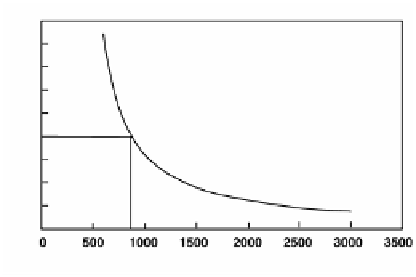Environmental Engineering Reference
In-Depth Information
measuring devices over an often uneven flow surface. Because of these
limitations, outdoor airflows are usually determined indirectly using one or
more techniques, e.g., CO
and tracer gas measurements, and conducting
2
enthalpy balances.
techniques. Outdoor airflow rates or effective ventilation rates
can be determined from measurements of CO
i.
CO
2
in return, supply, and outdoor
air. The percentage of outdoor air can be determined from Equation 8.1.
2
C
R
-
C
S
outdoor air (%)
=
-------------------
×
100
(8.1)
C
R
-
C
O
where C
= ppmv CO
in supply or mixed air in the AHU
S
2
C
= ppmv CO
in return air
R
2
C
= ppmv CO
in outdoor air
O
2
This outdoor air percentage can be converted to an outdoor airflow rate
using Equation 8.2.
% outdoor air
×
total airflow (CFM, L/s)
outdoor airflow rate (CFM, L/s)
=
-------------------------------------------------------------------------------------------------
(8.2)
100
The total airflow rate may be the volumetric flow rate into a room, zone,
AHU, or HVAC system determined from actual measurements.
Outdoor airflow rates can be determined by graphical methods. Assum-
ing that peak CO
levels occur at the time of measurement, ventilation rates
in CFM/person can be determined from
Figure 8.2
.
A peak CO
2
level of 800
ppmv would be equal to a ventilation rate of 20 CFM/person or approxi-
mately 10 L/s/person.
2
Figure 8.2
Outdoor air ventilation requirements as a function of peak indoor CO
2
concentrations. (From Salisbury, S.A., in Weekes, D.M. and Gammage, R.B., Eds.,
Proceedings Indoor Air Quality International Symposium: The Practitioner's Approach to
Indoor Air Quality Investigations
, American Industrial Hygiene Association, Fairfax,
VA, 1990, 87. With permission.)











